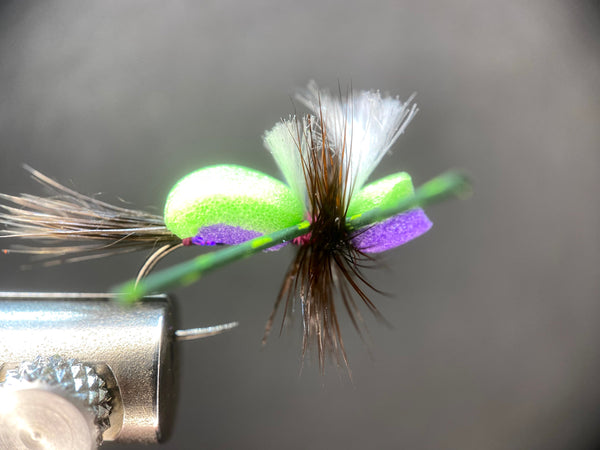Free Shipping in the USA
on orders over $100

Small Stream Fly Fishing

We are fortunate to live in an area with pristine and abundant water choices to choose from. World famous fisheries people travel from all over the world to fish, and honestly there is a reason why they do. These lakes and rivers provide some of the best fishing with opportunity for some very aggressive and large trout. We love fishing these waters and have found some spots that receive less pressure. There are some smaller water that provide some amazing fishing from small Idaho Desert Spring Creeks where the water is cool, and crystal clear holding healthy populations of smaller beautiful fish. To tributaries to these larger rivers and lakes that hold some large trout full of fight and aggression un matched any where else.
Small Stream Adventures

A big part of the experience here is actually the solitude of fishing without having to fight for space on the water with other anglers. It allows you to slow down and take in more of the scenic beauty, connect with your surroundings, ground your soul, and see what Mother Earth truly has to offer when we slow down a bit. No matter what your beliefs are it's nearly impossible to not be over taken by the beauty that surrounds you, and a deeper feeling of gratitude.
Small Stream Techniques and Reading Water

Although the techniques are similar, you will need to be able to adapt to a different environment for these fish. With less water the fish will be more concentrated in pockets, deeper pools, or runs. Reading and finding spots for fish to hold are easier in spotting because they are more pronounced, but the difficulty arises in some instances actually getting to the spots they are holding in due to climbing down rocks, big drop offs, and off course the over hanging brush that love to take your flies and scrape you up, or brake a rod tip or two. This is why it is so rewarding in part because of the effort it takes to get to these spots fewer anglers see, and the overly eager fish. We can fish everything from dry flies, nymphs, and even small streamers.
Where To Find and Locate Fish

When fly fishing these small streams here are a few keys to look for to find fish. Look for bends in the stream because many times as the stream bends it creates deeper pockets in the stream and provides some cover for fish from other predators so they can target prey as they pass by. Look for pockets in the gradient spots of the stream behind rocks, boulders, or logs. These provide areas with slightly deeper pools, and opportunities for fish to feed on things as they pass by. Look for over hanging brush that provide shade from the hot sun, abundant food source from insects falling into the water, and protection from predators. In some areas as it flattens out some look for some deep running pools, and beaver ponds. Some of our favorite fishing is done sneaking up on these ponds in the meadows to find some very large trout hiding in them.
Dry Fly Patterns and Technique

As far as flies go you will want to carry an assortment of dries in some larger sizes and terrestrials. Some of our favorite dry fly patterns are the Humpy a general all round attractor pattern. The Hippie Stomper as an attractor pattern, dry dropper fly with great floating properties. The Purple Haze tied in a variety of sizes to match any hatches that we may encounter such as PMDs, BWOs, or Flavs. We've found the Purple Haze works extremely well for either of these hatches with these hatches when matched with the proper size, sometimes as small as size 20.
Nymph Patterns and Technique

When it comes to Nymphs for these streams we never leave home without a Pheasant Tail Soft Hackle Nymph, purple is our go to color here as it holds its color best in water depths. We also carry some Copper John Soft Hackle Nymphs in a variety of colors. We carry some biot bodied nymph soft hackles in differing colors as well in varying sizes. These work amazing to match some of your Baetis or Mayfly Nymphs. If you didn't notice we prefer our nymphs to have a non traditional soft hackle on them. We do this because the natural current of the stream will give the fly movement during our dead drift or swing triggering the fishes feeding instincts without needing to twitch or do anything extra. After completing the swing or drift they are just as deadly on the retrieve.
Small Stream Micro Streamers and Techniques

Our favorite micro streamer patterns for this are a micro Slumpbuster tied in size 10, or 12. This pattern in this size though is equally deadly on the larger bodies of water as well, so don't over look the effectiveness of this pattern in smaller sizes. We also love the Jig Bugger and it's versatility to be fished on either a longer nymph rod or your traditionally shorter small stream light gear rods tied in size 8 through 14. We fish these with a traditional swing technique used by streamer anglers, and Steelhead, Salmon anglers. We've also implemented them on a dead drift with a retrieve at the end much like our nymphs. With the Jig Bugger in a smaller size I can drop it for a dead drift with a Hippie Stomper or large terrestrial pattern as an indicator providing an added option to entice the fish.
Blue Line/ Small Stream Exploring

We encourage you to take and explore some of the small blue lines that can be found in your area. You can do this by looking at a map and locating the blue lines, but look for the ones with other blue lines feeding into them to help find the ones with enough water to hold fish. You can go to a local fly shop and ask for these blue lines off the beaten path, or more secluded. Make sure and purchase something from them while your there to help support them for their knowledge and help. These are the two best ways to find these gems, along with talking to other anglers. Please though do not share spots other anglers are gracious enough to share, and keep them the gems that they are. Anglers don't share every spot because they don't want their spots to become over fished or crowded, and sharing those spots will destroy trust with fellow anglers.
Small Stream Rod Gear Choice

Now let's talk about gear to make sure and have to enjoy these spots. Let's start with the rod first. This is extremely important because you have to match your gear to where you are fishing. We use a 2wt through 4wt rod to ensure we're matching our rod to the fish we are catching to ensure we are able to enjoy the experience and the eagerness of the fish we catch. We prefer to use Fiberglass Rods in this case like the Moonlit Lunar Glass, or Nirvana Superglass. Glass rods reign supreme in these instances because they are soft to feel the play of the fish, but more importantly when you have to roll cast it helps to have a softer action rod that will bend deeper to load and shoot the line. Although you can overline your rods to do this, we prefer to use the Nirvana Performance Taper Line that is designed to quickly load your rod with fewer false casts, and optimal roll cast capabilities. Many times to many false casts will spook the fish. We also love a 10' 3wt nymph rod to fish dries, nymphs, and streamers with added reach to help with drifts, and fly control.
Small Stream Leader Set Up and Choice

Okay now to one of our specialties the leader set up. You can choose a 7 1/2 foot mono tapered leader for fishing this in a size 4-5x and do great. If you're looking for optimal performance though the Moonlit Brookie Furled Leader is the most versatile leader for fishing these small tight streams from fishing small dries with delicate presentations, to bigger terrestrial patterns, dry dropper, nymphs, two nymph set ups, and streamers this leader will flat out perform. These leaders also are perfect for helping anchor and roll cast with precision. They are extremely quick to change your flies, set up from dry to nymph, or choose fluorocarbon tippet to mono tippet.

Leave a comment